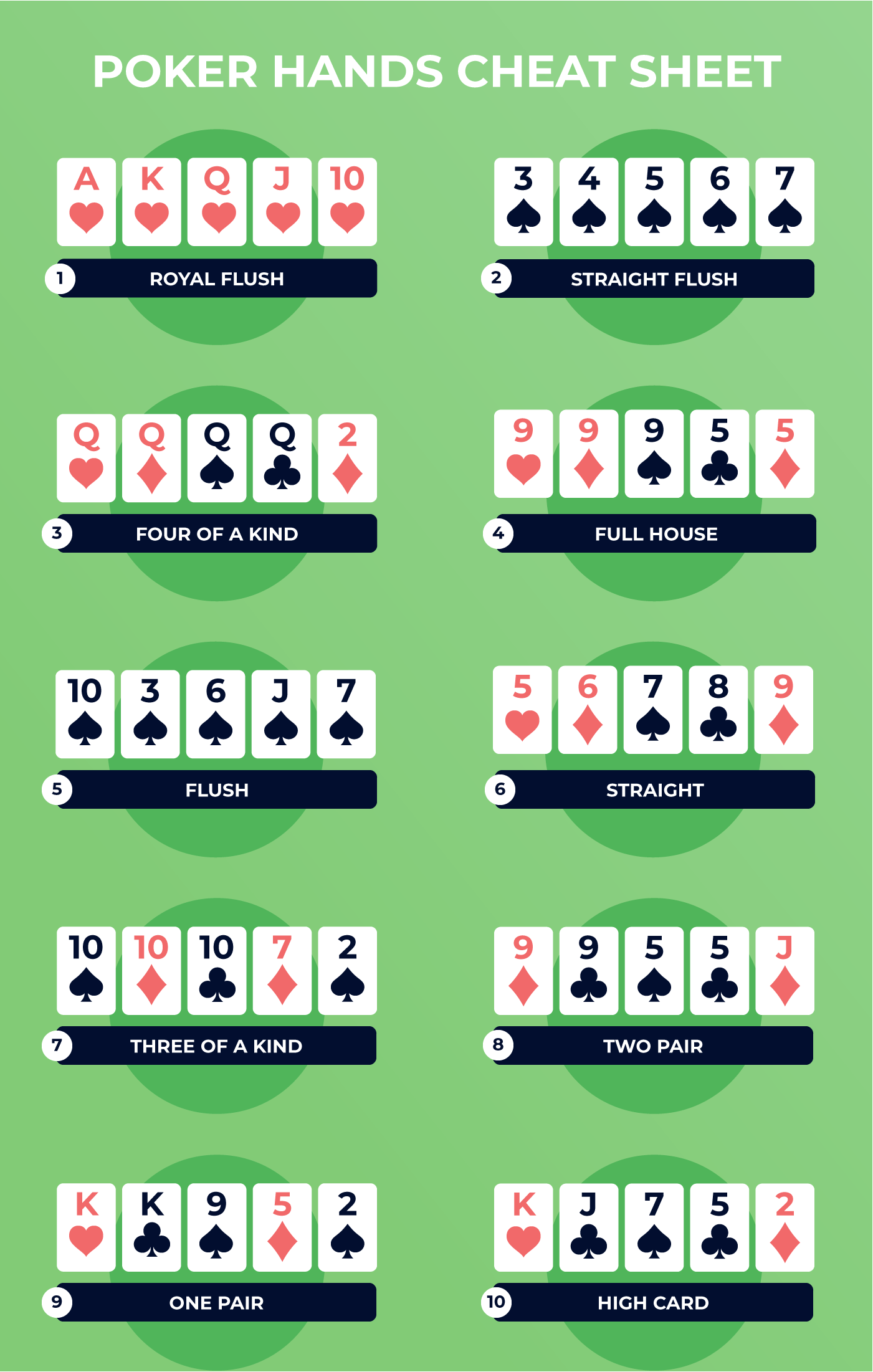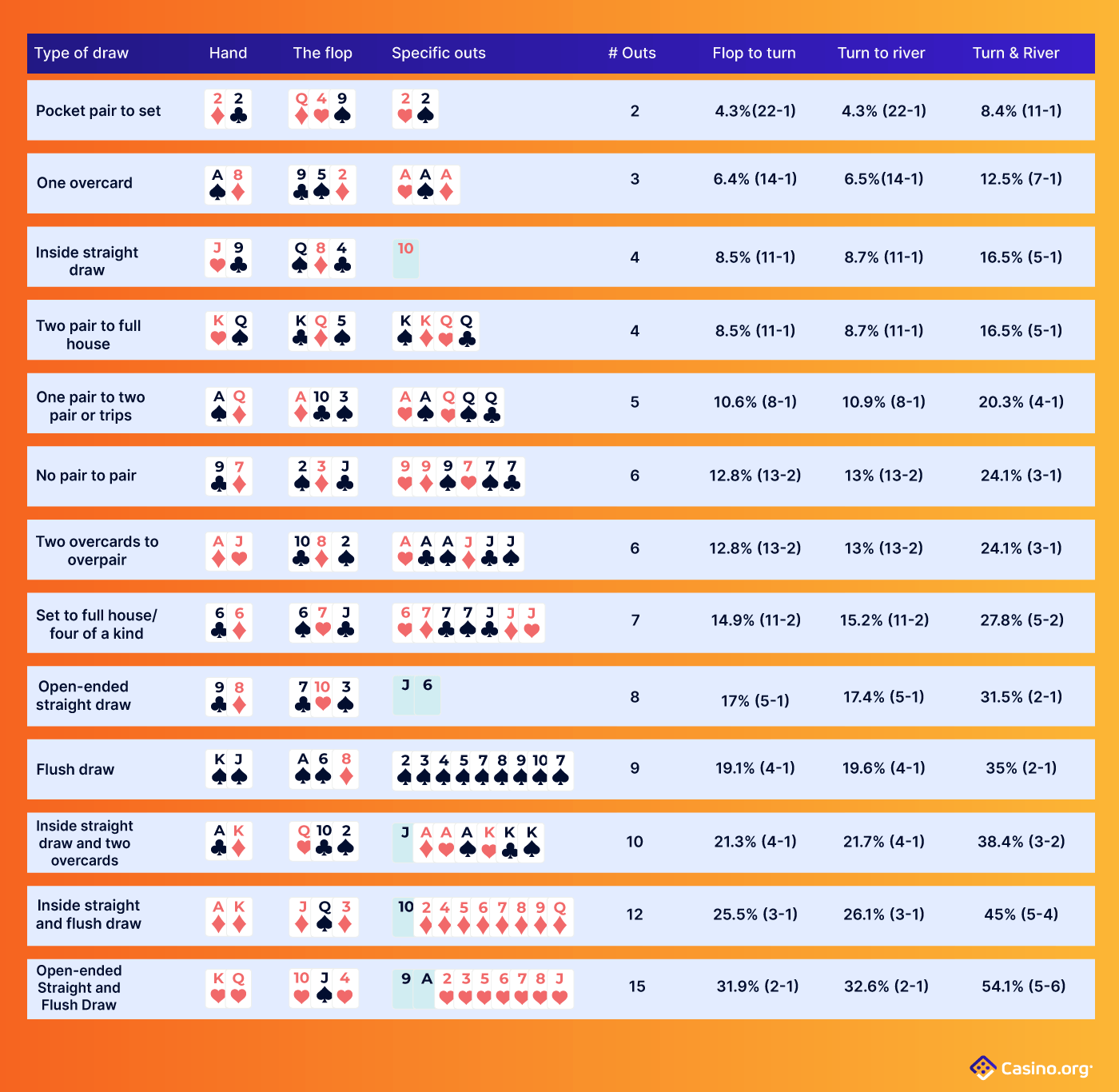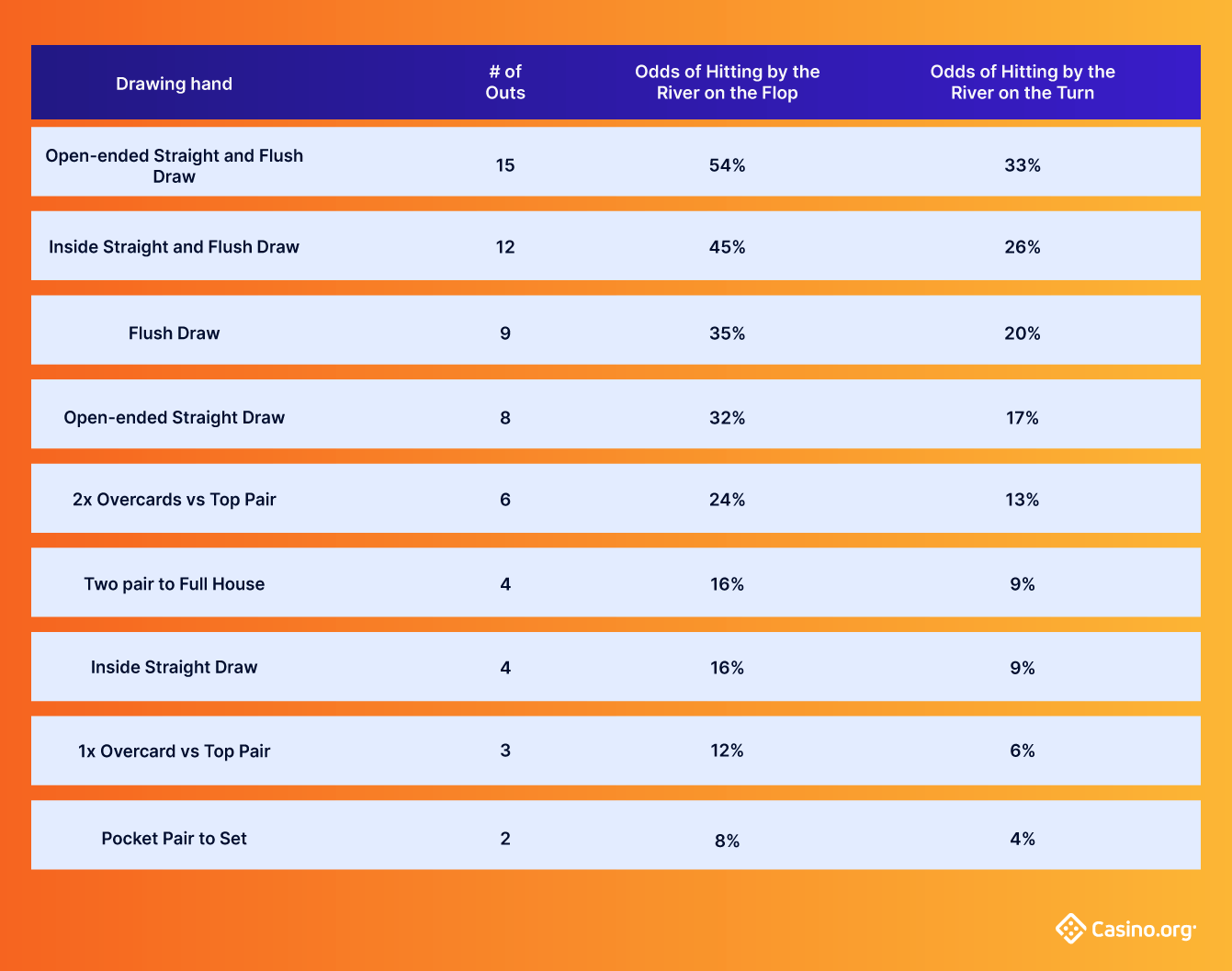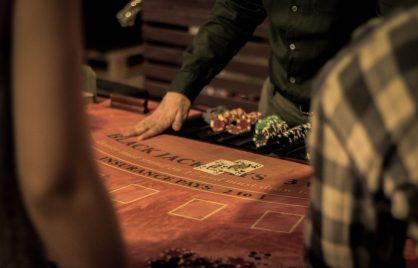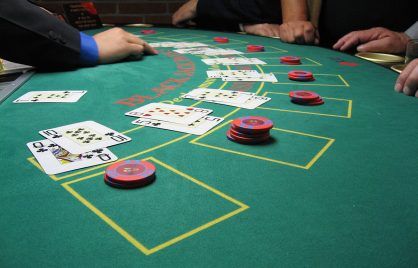How To Play Like A Pro: Easy Poker Cheat Sheets For Beginners
Use each poker cheat sheet in this guide to ground your game and establish solid fundamentals:
- Poker Hands Cheat Sheet
- Poker Staring Hands Cheat Sheet
- Poker Odds Cheat Sheet
- Calculating Outs Cheat Sheet
- Printable Poker Cheat Sheets
Don’t underestimate their power! When I first started playing poker, I didn’t even know how to hold my cards right. But I studied diligently and three months later, when I entered my first poker tournament, I won first place. The secret? Mastering the fundamentals.
I wasn’t a poker tells guru or mathematical whiz. What I did know was which cards to play and when – that alone was enough to have an extreme edge on my competition.
Poker Hands Cheat Sheet
For starters, remind yourself of the poker hand rankings, so you know what hands you’re trying to make.
But this poker hand cheat sheet alone isn’t enough to make you a great player. As with my story, the first place you really need to start is with what’s called your starting hands.
Poker Starting Hands Cheat Sheet
It may surprise you to know that professional poker players fold close to 80% of their hands… BEFORE the flop! Most hands are bad hands not valuable enough to enter the pot.
As I say in my book “A Girl’s Guide to Poker“, the first peek at your cards provides a mini rush, until you realize most of your hands are destined for the muck – poker’s trash pile.
…Truth is, most poker hands are awful. Statistical miscreants. Mathematical losers. That one D-list celebrity who can just never seem to get it together.
That’s right—the first thing you need to know about poker is that most hands are statistical losers. The fastest and easiest way to get ahead is by playing better cards than your opponents.
In a moment, you’ll see how to adjust which starting hands you play based on your position at the table. But for now, here’s your starting hands cheat sheet separated into three different levels:
Beginner
- Only play suited A-K-Q-J-T
Play any two cards that can make a royal flush. Said another way, BOTH of your cards need to be the same suit and either an Ace, King, Queen, Jack, or Ten. Nothing else counts.
If you implement this strategy, you will find yourself folding A LOT. That’s OK. Poker is a game of discipline – good habits start now.
Intermediate
When you’re ready to level-up and take your poker starting hands to the next level, stick to the following three categories: BROADWAYS, PAIRS, SUITED CONNECTORS.
- Broadway cards are A-K-Q-J-T, but they don’t have to be the same suit. So now you can play a hand like King-Queen even if they’re different suits (like the King of Clubs and Queen of Spades).
- Pairs are two of the same card, like a pair of nines or a pair of Jacks.
- Suited connectors are numerically consecutive and the same suit. Hands like a nine and eight of spades or a six and seven of diamonds. What if you’re dealt a nine and ten of different suits? Fold it!
These are card categories you can loosely play in any position.
Advanced
You really begin to develop your edge when you fine-tune which cards to play based on position. This is a preflop raise first-in guide. These are the hands you raise if no one else has raised ahead of you.
First what you do is determine your position at the table. Then you check this cheat sheet to see which starting hands you should raise.
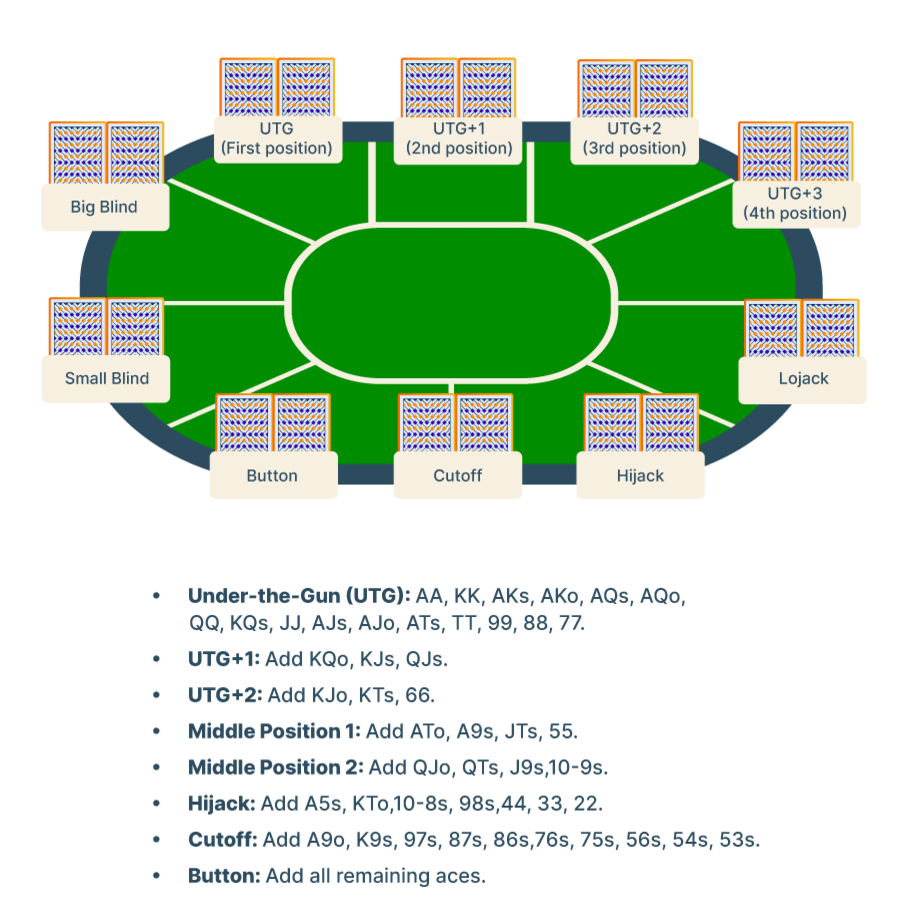
What if I don’t want to follow these rules? Poker is for you—obviously play the game you want to play. This is just a foundation. As your skill level increases, you can deviate from these norms based on player types, stack sizes, preflop action, and so on.
However, you do want to know the general reasoning behind these tight guidelines.
The Guidelines Explained
Why do you want both cards to be broadways?
Why not just play any starting hand with an Ace? The problem is that you will often find yourself “outkicked” —meaning if you do this, your Ace-Eight will lose to someone else’s Ace-Jack. It is going to cost you significantly because you will hit a good hand that is second-best. Poker doesn’t reward silver medals.
Why do you want to play pairs?
When two of your hole cards match, it’s called a pocket pair. This is great because you already have what’s called a “made hand”—you don’t need to connect with the flop! A pair is a pair and no one can take that away from you. (Not even the government.) It’s also surprisingly hard to flop a pair.
- You’re only going to connect with the flop around one-third of the time.
- This also applies to your opponents. A pair provides a nice head start because they’re usually going to miss.
Why do you want to play suited connectors?
Number cards are the hardest to play because they are much less likely to be the best hand at showdown. Flopping a pair of sixes isn’t going to hold up frequently enough… and even if it does, the pot will surely be small. You play suited connectors for their ability to hit straights and flushes.
This is also not a guarantee, which is why you shouldn’t play these starting hands until you’re comfortable bluffing. You need to be confident playing draws.
Let’s say you have 8♠-9♠ and the flop is A♠-K♠-4♥. Sure, another spade will improve you to a flush and most likely give you the winning hand—but what do you do if another spade doesn’t hit? You’re going to need to have a back-up plan.
For all the times your straights and flushes don’t come in, you’re going to need to know when a bluff will be successful vs. when it’s better to give-up (sometimes your opponent just isn’t folding). Suited connector starting hands require more advanced post-flop strategy, unlike a hand like pocket aces which is strong enough to win on its own.
Poker Odds Cheat Sheet
Here’s a beginners cheat sheet for poker odds. You can print this out like a master list or keep reading as I break the most important ones down in more detail.
- Flopping a pair… 29%
- Flopping two pair… 2%
- Flopping a set… 12%
- Flopping a flush… 0.84%
- Flopping a straight with two connected hole cards… 1.3%
- Making a flush by the river… 35%
- Making an open-ended straight by the river… 32%
- Making a gutshot straight by the river … 16%
- Making a full house by the river if you’ve flopped a set… 33%
- Pocket pair vs two overcards … 51%
- Lower pocket pair against higher pocket pair … 18%
- Pair vs one overcard … 70%
- Kicker pairing … 25%
- Pairing either overcard after the flop … 25%
- Backdoor/runner-runner flush … 4%
Even though this is a poker cheat sheet for beginners, you’d be surprised how many regulars don’t know some of these essentials. People chase backdoor flushes all the time – even though they’ll miss with near 95% frequency.
Tip: A backdoor flush is when you need both the turn and river to be the same suit in order to make your flush. For example, if you have K♥J♥ and the flop is 8♠9♠3♥, you need both the turn and river to be a heart in order to complete a flush.
You can also refer to this poker odds cheat sheet featuring common scenarios to help you calculate odds when trying to improve your hand.
These are the 3 most vital poker probabilities for you to know:
- Making a flush by the river… 35%
- Making an open-ended straight by the river… 32%
- Pocket pair vs. two overcards … 51%
Making a flush or straight with one card to come rather than two—ex. You’ve flopped a straight draw and want to know your probability of hitting your straight on the turn—means you just cut the statistic in half. So making a straight is about 16% and a flush is about 17.5%.
The pocket pair vs. two overcards is a scenario commonly referred to as a FLIP… because it’s nearly a coin toss. A hand like pocket tens vs. Ace-King will win just over 50% of the time. Poker players will frequently say, “we’re flipping!” when you’re racing a pair against two higher cards.
What I recommend all beginners do is download a poker odds calculator app on your smartphone (there are many) and plug-in the hands yourself. If you do this enough, you will see the same probabilities appear over and over again. It’s an easy way to begin to recognize standard situations and statistics.
Calculating Outs Cheat Sheet
An alternate way to look at your hand’s chances of winning is calculating “outs.” Think of how many cards are available in the deck to give you the best hand.
If you need to hit an open-ended straight draw for example, then you have eight outs. For example, you hold 7♣6♣. Flop is 9♦8♥3♠. Any 5 or 10 will make you a straight. There are four 5s in the deck and four 10s, meaning you have eight cards to hit for the winner.
- Multiply your number of outs by four in order to roughly calculate your odds of hitting on the river.
- Multiply your number of outs by two in order to roughly calculate your odds of hitting on the turn.
Example:
Flush draws contain nine outs (there are 13 cards of each suit in the deck, subtract the two in your hand and the two on the flop). Multiply 9 x 4 to calculate your likelihood of hitting your flush by the river (36%) and multiply 9 x 2 to calculate your likelihood of hitting your flush by the turn (18%).
Some people prefer to calculate outs and run these equities in their heads. I can assure you however it’s not necessary—if you follow this poker cheat sheet, then you will see the same odds and statistics pop-up so regularly you’ll naturally store them to memory.
Printable Poker Cheat Sheets
Use the links below to print poker cheat sheet PDFs, or download them to refer to later.
For more guides from Amanda, check out What Is A Straddle In Poker?
